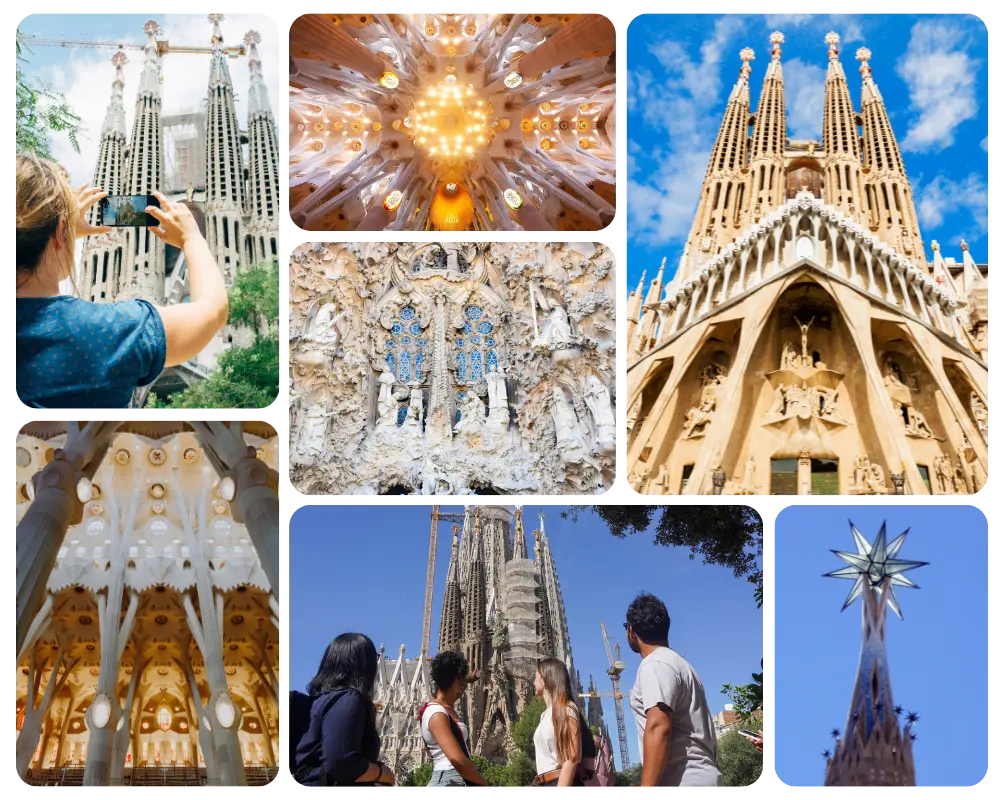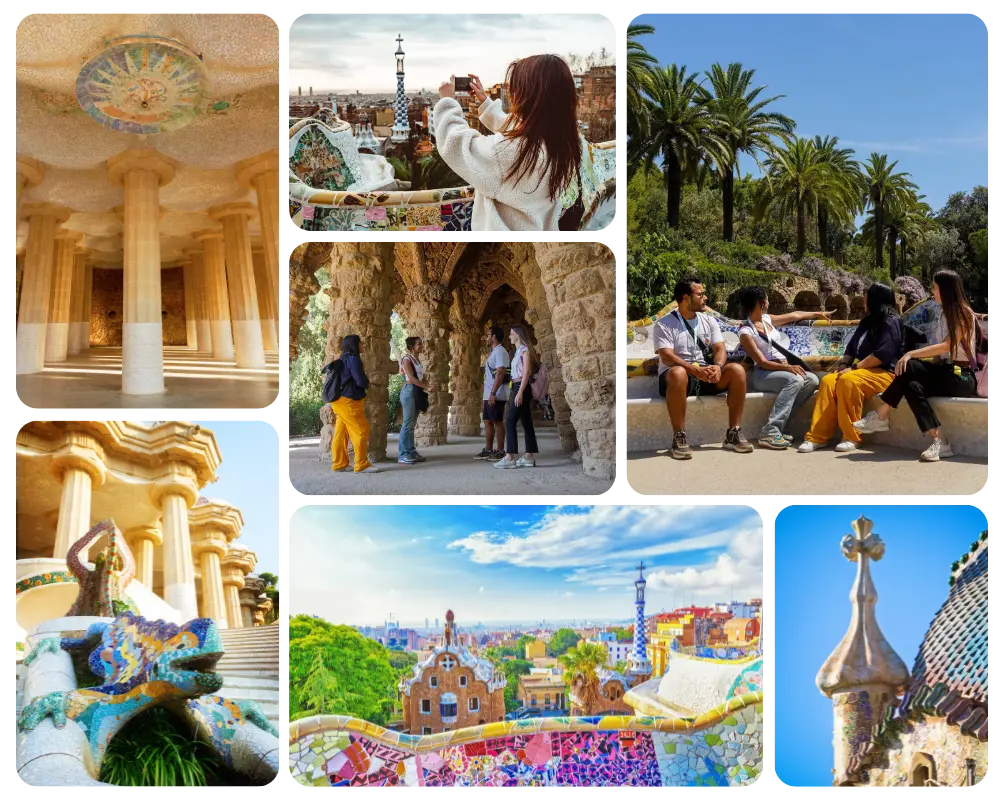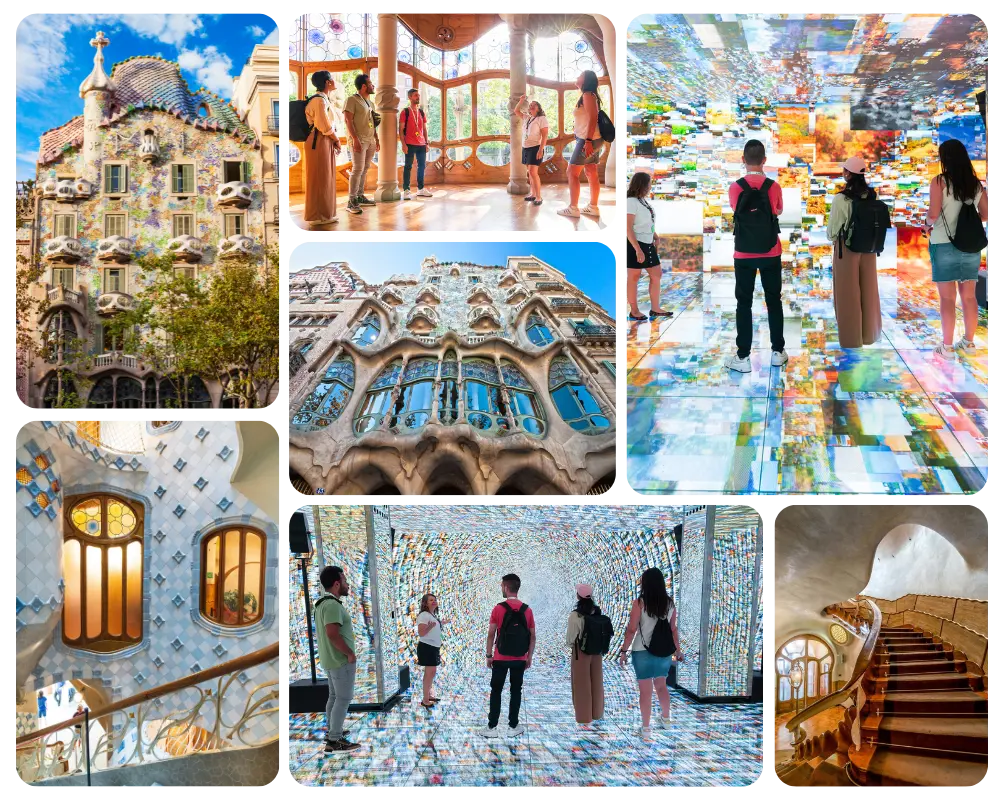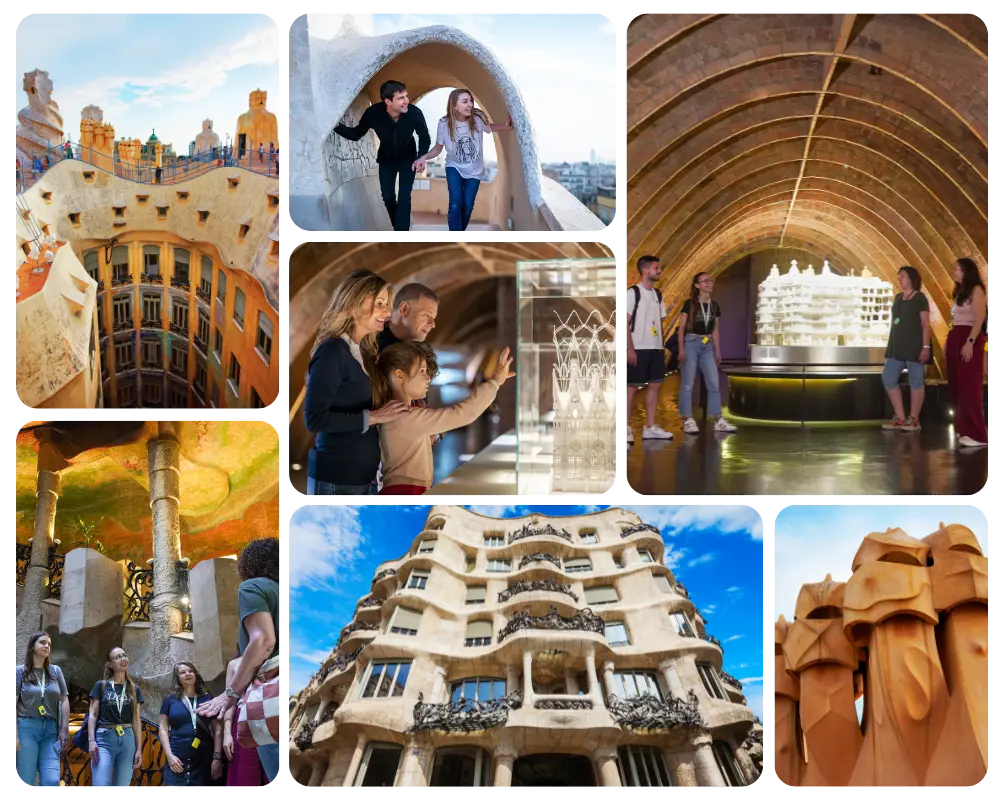Barcelona would be a very different city without the influence of Antoni Gaudí.
In this article, we will explore four of Antoni Gaudí’s masterpieces and their profound influence on the city, focusing specifically on how you can explore these iconic works using the convenient services of the Barcelona hop on hop off buses offered by Barcelona City Tour. Get ready for a unique journey through Gaudí’s wonders!
1. La Sagrada Familia
Our tour begins with La Sagrada Familia, Gaudí’s masterpiece and one of the most iconic structures in the world. This majestic basilica has been under construction since 1882 and is the most visited monument in Barcelona.

The design of La Sagrada Familia is a work of art, combining forms inspired by nature with religious symbolism. Its detailed facades, tree trunk-like columns, and stunning stained glass windows create an atmosphere that leaves visitors breathless. Gaudí infused his unique vision of architecture into every corner of this remarkable basilica.
How to Get to Sagrada Familia
There are several ways to reach Sagrada Familia, and here are the best transportation options:
- Metro: Barcelona’s L2 and L5 metro lines stop right at the entrance of the basilica, making it incredibly easy for those who prefer the underground transit option.
- Bus: You can take bus lines 19, 33, 34, D50, H10, and B24, which stop near La Sagrada Familia, allowing you to enjoy a scenic ride through the city before reaching your destination.
- Barcelona Tourist Bus: Hop on the Green Route of the Barcelona hop on hop off bus offered by the Barcelona City Tour and get off at Stop 11.
For those interested in a more enriching experience, we recommend taking a guided tour to fully appreciate the history and architecture of Sagrada Familia. These tours offer a detailed insight into the hidden secrets behind every aspect of its design, revealing the true genius of Gaudí.
2. Park Güell
Our next stop is Park Güell, a magical place where nature and architecture blend seamlessly to create a dreamlike environment. This urban park, designed as an ideal garden city, is one of Gaudí’s most innovative works and reflects his love for organic shapes and vibrant colors.
Park Güell is renowned for its Dragon Staircase, the Nature Square, and the Washerwoman’s Portico, among other unique features. The mosaic dragon that adorns the staircase is not only a visual icon but also part of a complex drainage system designed by Gaudí to manage rainwater and maintain the park in perfect harmony with the environment.
Moreover, from the top of the park, visitors can enjoy breathtaking panoramic views of Barcelona.

Secrets of Park Güell
This park holds numerous secrets and fascinating details. For instance, the slanted columns of the Washerwoman’s Portico are designed to mimic palm trees, while the central square is supported by columns resembling a forest. Every element of Park Güell is carefully planned to evoke a sense of connection with nature, and a guided tour can reveal these hidden aspects that many tourists often overlook.
How to Get to Park Güell
Here are the most convenient options for reaching Park Güell:
- Metro: Take Line 3 to the Lesseps station, from which it’s a 20-minute walk to the park. The recommended entrance is via Avinguda del Santuari de Sant Josep de la Muntanya, which features escalators for easier access. Note that the Vallcarca stop on the same line is not recommended due to its escalators often being out of service.
- Bus: Lines H6 and D40 offer nearby stops at Travessera de Dalt, from where a 10-minute walk will bring you to the park. As with the metro, entering through Avinguda del Santuari de Sant Josep de la Muntanya or Larrard Street is advised for an easier entry.
- Barcelona Tourist Bus: The Barcelona hop on hop off bus has a stop conveniently located at Stop 13 on the East/Green Route, just a short 5-8 minute walk from the park. Opting for the hop on hop off bus allows you to explore Park Güell efficiently and without stress.
3. Casa Batlló
Our next destination on this tour of Gaudí’s works in Barcelona is Casa Batlló, situated on the famous Passeig de Gracia. This building is a true gem of Catalan modernism.

Casa Batlló was declared a UNESCO World Heritage Site in 2005, and it’s easy to see why. The facade of Casa Batlló is one of its most remarkable aspects, with undulating lines that resemble the scales of a dragon and balconies that appear like carnival masks. Upon entering, you are immersed in a dreamlike world where every detail comes to life, showcasing Gaudí’s limitless creativity. The interior columns mimic tree trunks, while the multicolored stained glass windows depict the sky and sea, creating a unique and captivating atmosphere.
How to Get to Casa Batlló
Here are the best ways to reach Casa Batlló:
- Metro: You can take lines L2 or L4 to the Passeig de Gràcia station. Once you exit, follow the signs to the “Passeig de Gràcia / Gran Via” exit and walk about 150 meters to reach Casa Batlló.
- Bus: Bus lines V15, 7, 16, 22, and 24 have stops nearby at Passeig de Gràcia / Aragó. From there, it’s just a 100-meter walk to Casa Batlló.
- On Foot: If you’re in the center of Barcelona, a 10-15 minute walk along Passeig de Gracia will take you directly to Casa Batlló.
- Barcelona Tourist Bus: the Barcelona hop on hop off bus provides two stop options: Stop 16 on the East/Green Route for “Casa Batlló” and Stop 19 on the Orange Route for “Casa Batlló.”
We highly recommend visiting Casa Batlló through a guided tour with access to the Gaudí Cube Experience to ensure you don’t miss any details!
4. La Pedrera o Casa Milà
Also known as Casa Milà, La Pedrera is the final stop on our journey. Constructed between 1906 and 1912, this building was commissioned by the entrepreneur Pere Milà as a private residence and apartment space. La Pedrera’s facade is one of its most distinctive features, with wavy lines that evoke the movement of the sea. Gaudí used local limestone to create a textured and organic surface, and the wrought iron balconies present unique designs on each level.

La Pedrera has a rich and varied history. During the Spanish Civil War, the building’s basements served as air raid shelters, and its innovative design was initially met with criticism and fines from the city council for its unconventional nature. Today, however, it stands as a museum and cultural center celebrating Gaudí’s masterful work.
How to Get to La Pedrera
Here are the best ways to reach La Pedrera:
- Metro: Line L3 takes you to the Diagonal station, from which it’s just a short walk down Passeig de Gracia to reach La Pedrera.
- Bus: Lines 7, 16, 17, 22, 24, and V17 have stops nearby at Passeig de Gràcia / Provença, just steps away from La Pedrera.
- Barcelona hop on hop off bus: The East/Green Route of the Barcelona tourist bus has a stop right in front of La Pedrera, making the Barcelona tourist bus an ideal option for visiting this attraction along with other city highlights.
La Pedrera’s proximity to Casa Batlló allows visitors to explore both attractions in a single visit, making this tour an unforgettable experience.
Now that you know about these four architectural marvels of Antoni Gaudí in Barcelona, you are ready to plan your itinerary and embark on an unforgettable journey. Whether you choose a guided tour or decide to explore on your own, we recommend not missing these attractions, as they represent the essence of Barcelona and Gaudí’s genius.
To maximize your experience, consider using the Barcelona hop on hop off bus by Barcelona City Tour, which allows you to comfortably explore the city’s main attractions while avoiding typical public transport delays.
Share your experiences with us on social media and follow our recommendations for inspiration on your next trip to Barcelona!


